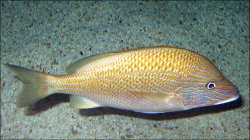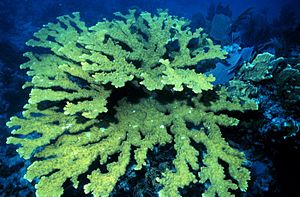Fauna of Puerto Rico facts for kids
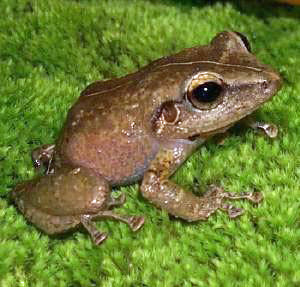
The animals of Puerto Rico are much like those on other islands. Many species are found nowhere else in the world (this is called endemism). However, there aren't as many different types of animals compared to larger landmasses. Bats are the only native land mammals still living in Puerto Rico. Other land mammals, like cats, goats, sheep, and monkeys, were brought by people. In the ocean, you can find dolphins, manatees, and whales. Out of 349 bird species, about 120 lay their eggs in Puerto Rico. Many others are just visiting or rare.
The most well-known animal in Puerto Rico is probably the common coquí. This small frog is found only here. It is one of 86 types of amphibians and reptiles in Puerto Rico. Some native freshwater fish live in Puerto Rico's waters. But many fish species were brought by humans and now live in reservoirs and rivers. Even among tiny creatures like invertebrates (animals without backbones), there are many different kinds, but not a huge variety of groups.
When the first people arrived about 4,000 years ago, and then Europeans more than 500 years ago, they greatly changed Puerto Rico's animals. Hunting, destroying natural homes (habitat), and bringing in new species led to some animals disappearing forever (extinction) or from Puerto Rico (local extinction). Efforts to protect animals, especially the Puerto Rican parrot, started in the mid-1900s. As of 2002, 21 species in Puerto Rico were considered threatened. These included two mammals, eight birds, eight reptiles, and three amphibians.
Contents
How Puerto Rico's Animals Arrived
Puerto Rico sits on a huge piece of the Earth's crust called the Caribbean Plate. This plate formed a long time ago. Scientists believe that when South America moved away from Africa, a chain of volcanoes formed. This chain later split into the islands we know today, like the Greater Antilles (which includes Puerto Rico) and the Lesser Antilles. Puerto Rico itself is quite young in terms of geology, forming about 135 million years ago.
Most scientists think that the ancestors of today's animals came to the Antilles by floating across the ocean. They likely came from South America. This is called "overwater dispersal." For example, frogs like Eleutherodactylus spread from island to island this way. However, some animals, like certain insect-eating mammals and freshwater fish, might have arrived earlier through other ways. One idea is that ancient spiny rats (echimyids) reached the Greater Antilles from South America by "island-hopping" or floating on rafts of plants.
Another idea suggests that land mammals arrived around 34 million years ago. At that time, a temporary land bridge called "GAARlandia" connected northwestern South America to Cuba, Hispaniola, and Puerto Rico. After this land bridge broke apart, the animals on the islands started to evolve into new species.
The last big changes to Puerto Rico's animals happened about 10,000 years ago. After the last Ice Age, sea levels rose. This changed Puerto Rico from a dry grassland to a moist, forested island. Many animals died out because of these changes. Around this time, the Puerto Rican Bank, which included Puerto Rico and most of the Virgin Islands, became separate islands.
Mammals
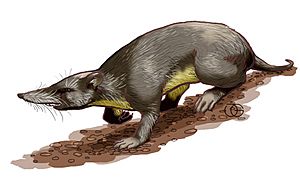
Puerto Rico doesn't have many types of native mammals compared to larger continents. Today, there are only 13 native land mammals, and all of them are bats. However, 18 types of marine mammals, like manatees, dolphins, and whales, live in the waters around Puerto Rico. Old fossils show that in the past, Puerto Rico had a shrew, a sloth, more types of bats, and five kinds of rodents. Scientists think these animals died out because they couldn't adapt to fast changes in climate or new animals brought by humans.
Other land mammals have been brought to Puerto Rico over time. The first people brought dogs and guinea pigs. Later, the Taíno brought hutias (a type of rodent) for food. When the Spanish arrived in the 1500s, they brought farm animals like dogs, cats, goats, pigs, cows, horses, and donkeys. Other animals, like black rats, Norway rats, and house mice, came by accident, possibly with Christopher Columbus in 1493. More recently, some animals were brought to control pests. For example, the small Asian mongoose was brought in the 1800s to control rats in sugar cane fields. But this didn't work. The mongoose didn't control the rats and instead harmed native animals like the yellow-shouldered blackbird.
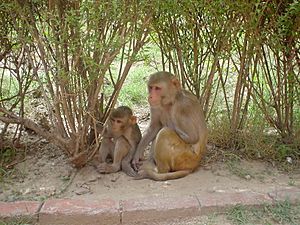
In 1967, 57 rhesus macaques (a type of monkey) were brought to Desecheo Island for a study. Before this, Desecheo was a big nesting place for brown boobies. But because the macaques ate their eggs, no birds nest there anymore. Efforts to remove the monkeys have not worked, and they have spread to southwestern Puerto Rico. Other monkeys have also made homes in Puerto Rico. In the late 1970s, 107 squirrel monkeys escaped from a research station. Now, about 35 of them still live in the wild.
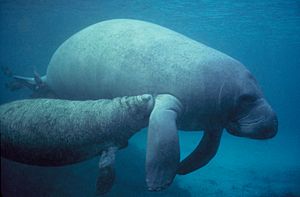
One of the most famous water mammals in Puerto Rico is the West Indian manatee. This animal is listed as vulnerable by conservation groups. Puerto Rico's waters are an important place for manatees to have their babies. A baby manatee named Moisés became famous when he was rescued and cared for by a local group. He was the first orphaned manatee successfully returned to the wild in the Caribbean. A town in Puerto Rico, Manatí, is believed to be named after this animal.
Puerto Rico's waters are also a key breeding spot for humpback whales during the winter. Watching these whales is a popular tourist activity in Rincón, on the west side of the island.
Bats
The bats living in Puerto Rico today belong to five different families. There are 13 species in total, and six of them are unique to Puerto Rico. Seven of these bats eat insects, four eat fruit, one drinks nectar from flowers, and one eats fish. This number of bat species is low compared to other large Caribbean islands. For example, Jamaica, which is only a bit bigger than Puerto Rico, has 21 bat species. This might be because Puerto Rico is farther from the mainlands where bats spread from.
Bats are very important for the forests and caves in Puerto Rico. They also help control mosquito populations. Most bats (10 out of 13 species) live in caves and don't have many babies. The Caribbean National Forest has the most types of bats, with eleven species. The red fig-eating bat, which is only found in Puerto Rico, helps spread the seeds of an important tree called bulletwood. Bat droppings (guano) in caves provide food for many other cave-dwelling creatures.
Some of the bat species found in Puerto Rico are: the greater bulldog bat, Antillean ghost-faced bat, Parnell's mustached bat, sooty mustached bat, Jamaican fruit bat, Antillean fruit bat, buffy flower bat, Leach's single leaf bat, red fruit bat, big brown bat, eastern red bat, velvety free-tailed bat, and Mexican free-tailed bat.
Birds

Puerto Rico has 349 different kinds of birds. 18 of these birds are found only in Puerto Rico. Almost half of the species (166) are "accidental" visitors, meaning they've only been seen once or twice. 42 species were brought by humans, either directly or indirectly. About 120 species, both native and introduced, regularly breed in Puerto Rico.
Most birds in the West Indies came from North and Central America. Some South American bird families, like hummingbirds and tyrant flycatchers, have also recently arrived. Scientists think birds came to the West Indies by flying across the ocean during the Ice Ages. The most ancient birds in the West Indies are the todies, and Puerto Rico has its own unique tody.
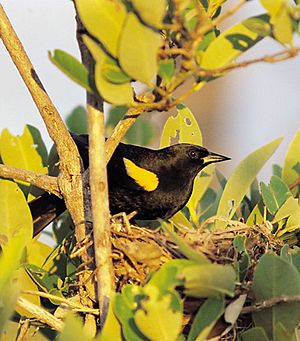
Puerto Rico's bird population has shrunk because of extinctions and local disappearances, caused by nature or by humans. For example, a type of swift called Tachornis uranoceles lived here between 17,000 and 21,000 years ago but died out after the Ice Age changed its habitat. At least six unique bird species have disappeared in the last thousand years. These include the Puerto Rican barn owl and the Puerto Rican conure. The Puerto Rican parrot almost became the seventh. In 1975, there were only 13 left! But conservation efforts helped save them. Still, it's one of the ten most endangered birds in the world. Four other birds, like the Hispaniolan parakeet, disappeared from Puerto Rico after the population grew in the late 1800s. Three more species no longer breed here.
Amphibians and Reptiles
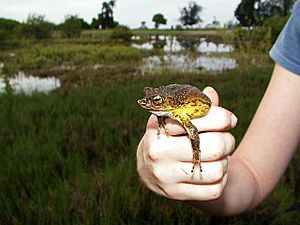
Puerto Rico has 25 types of amphibians and 61 types of reptiles. Most land reptiles in the West Indies are thought to have arrived by floating on natural rafts of plants from South America. Because of this, Puerto Rico and the Caribbean have one of the highest numbers of unique amphibian and reptile species in the world. Amphibians in Puerto Rico include toads and frogs. Reptiles include turtles (both freshwater and marine), lizards, worm lizards, snakes, and a caiman.
All the frogs from the Ranidae and Hylidae families in Puerto Rico were brought here by humans. One type of toad, the cane toad, was introduced, while the Puerto Rican crested toad is native and critically endangered. The cane toad was brought in the 1920s to control a sugar cane pest. All the frogs from the Leptodactylidae family are native. Of these, 17 are from the genus Eleutherodactylus and are known as coquís. Three of these, like the golden coqui, are probably extinct. The common coquí is an unofficial symbol of Puerto Rico and an important part of its culture. Since 14 of the 17 coquís are unique to Puerto Rico, people often say, "De aquí como el coquí" (From here like the coquí) to show their pride.
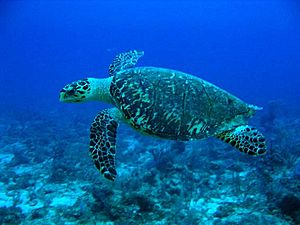
Puerto Rico has five types of freshwater turtles (two are extinct) and five types of sea turtles. Two of these, the hawksbill turtle and the leatherback sea turtle, are critically endangered. They are threatened by habitat loss and illegal collection of their eggs. The spectacled caiman, an introduced species, is the only crocodile-like animal in Puerto Rico.

The 11 snake species in Puerto Rico are generally not venomous. However, one species, the Puerto Rican racer, does have venom. The largest snake in Puerto Rico is the Puerto Rican boa, which can grow up to 12 feet long. Snakes in Puerto Rico eat other reptiles, frogs, and sometimes mice, birds, and bats.
The largest land lizard in Puerto Rico is the Mona ground iguana. It lives only on Mona Island. Another large iguana, the Anegada ground iguana, used to live here but disappeared due to predators and habitat loss. The most common lizard in Puerto Rico is the sharp-mouthed lizard. The anole lizards in the Greater Antilles are a great example of how animals adapt to different environments. Even though they evolved separately on each island, they developed similar types of lizards that specialize in different habitats.
Fish
The first descriptions of fish from Puerto Rico were made in 1828. Puerto Rico has few native freshwater fish species. However, over 30 introduced species, mostly from Africa, South America, and the southeastern United States, have made homes here. Also, 60 marine species use Puerto Rico's freshwaters at different times of the year. Some fish were brought on purpose for sport fishing, mosquito control, or as bait. Others, like the sailfin armored catfish, were released by accident from aquariums. Since 1936, Puerto Rico has a fish hatchery in Maricao. About 25,000 fish, including largemouth bass and channel catfish, are raised there each year to stock Puerto Rico's lakes and rivers.
Puerto Rico's ocean waters have three main habitats: mangroves, reefs, and seagrasses. A total of 677 fish species live in these areas, with 242 being reef species. Common reef fish include wrasses, damselfishes, white grunts, and sharks. Sea breams and yellowfin mojarras are often found in mangrove areas. Other interesting fish include flatfishes (21 types) and sharks (over 20 types). Oceanic whitetip sharks and silky sharks are common in the Mona Passage.
Invertebrates
Puerto Rico has many different kinds of invertebrates (animals without backbones), but not as many different groups as larger tropical areas. Compared to other Caribbean islands, Puerto Rico has been studied a lot for its invertebrates.
Puerto Rico's insect population is considered smaller compared to similar areas on continents. For example, Puerto Rico has about 300 species of butterfly, while Trinidad has over 600, and a small area in Brazil has over 1,500. As of 1998, only 5,573 insect species had been recorded in Puerto Rico, out of an estimated 925,000 described species worldwide. Of the 31 main insect groups, 27 are found in Puerto Rico. The largest collection of insects in Puerto Rico is at the Museum of Entomology and Tropical Biodiversity at the University of Puerto Rico.
Arachnids, like spiders, are important in forest ecosystems. They are both predators and prey. In some forests, spiders are the main predators of other invertebrates living in trees. The Maricao Commonwealth Forest has 27 spider species. Theotima minutissima, a tiny spider found in the Caribbean National Forest, is thought to reproduce without a male.
Other land invertebrates in Puerto Rico include earthworms and cave animals. Eighteen native earthworm species have been described. Seventy-eight invertebrate species live in Puerto Rico's caves. Six of these are found only in the Antilles, 23 come from North America, and 23 are unique to Puerto Rico. Only two species are known to live only in caves. Many of these cave animals are predators, while others eat bat droppings or plants. Most of these animals are believed to have arrived in Puerto Rico during the Ice Age.
The marine invertebrates of Puerto Rico include 61 types of sponges, 171 cnidarians (like jellyfish), 1,176 mollusks (like snails and clams), 342 crustaceans (like crabs and shrimp), and many types of corals. The coral species found in Puerto Rico's reefs are typical of the Caribbean. Common corals include boulder star coral, finger coral, and elkhorn coral.
Introduced invertebrates have also changed Puerto Rico's animal life. Native freshwater snails have been harmed by new species. The most common freshwater snail in Puerto Rico now is the Quilted Melania, which was introduced. The honeybee is another introduced invertebrate. It competes with the endangered Puerto Rican parrot for nesting spots. Africanized bees, which are even more dangerous, have also recently arrived in Puerto Rico. Other introduced invertebrates include 18 species of ant.
Human Impact and Conservation
Humans have affected Puerto Rico's animals since the first settlers arrived about 4,000 years ago. The native animals were used for food, skins, and trade. Big drops in animal populations and types likely began after Europeans arrived in the 1500s. Destroying habitats, especially clearing forests for sugar cane farms, greatly harmed Puerto Rico's animals in the late 1800s. Also, animals brought by humans, like rats, cats, the small Asian mongoose, and the cane toad, have had a big impact. Rats on Monito Island limit the number of the unique Monito gecko. Wild cats on Mona Island attack birds and reptiles. Mongooses have been seen eating young Puerto Rican parrots.
Conservation efforts include protecting both land and species. About 3.4% of Puerto Rico's land is protected in 34 reserves. According to the IUCN, 21 species in Puerto Rico are threatened. The U.S. federal government lists 5 mammals, 2 amphibians, 8 birds, and 10 reptiles as endangered. The Puerto Rican government also has its own list, which includes 18 critically endangered species and 14 endangered species.
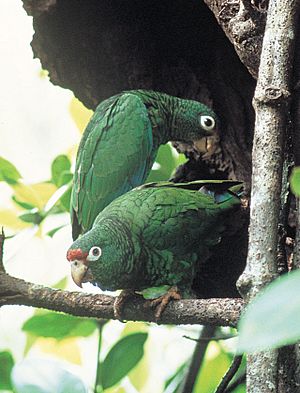
Birds currently get the most attention for conservation. The Puerto Rican Parrot Recovery Plan is one of the most successful animal recovery plans in Puerto Rico. Started in 1968, its goal was to improve the parrot's status by 2020. Other goals include creating two healthy wild populations and protecting their habitat. Currently, there are about 44 wild parrots and 105 in captivity. This program has greatly helped people in Puerto Rico understand the importance of protecting nature.
The Puerto Rico Breeding Bird Survey, started in 1997, tracks the health of Puerto Rico's breeding bird populations. This information helps the U.S. Fish and Wildlife Service decide which birds need the most help. Other conservation programs include protecting migratory birds and maintaining five wildlife refuges.
Protecting marine life has also gained support in Puerto Rico recently. The island has about 700 miles of coastline and 1,300 square miles of coral reefs. The Department of Natural Resources of Puerto Rico manages 25 marine protected areas. All sea turtle species in Puerto Rico's waters are endangered or threatened. Programs supporting turtle conservation have helped reduce egg poaching and the eating of turtle meat.
 In Spanish: Fauna de Puerto Rico para niños
In Spanish: Fauna de Puerto Rico para niños



